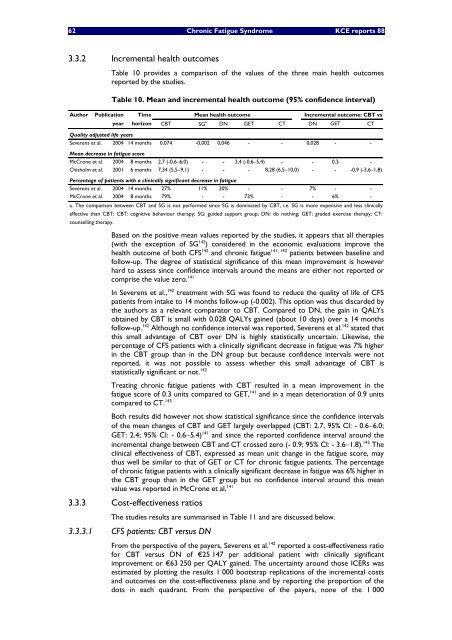Chronisch Vermoeidheidssyndroom: diagnose, behandeling en ...
Chronisch Vermoeidheidssyndroom: diagnose, behandeling en ...
Chronisch Vermoeidheidssyndroom: diagnose, behandeling en ...
You also want an ePaper? Increase the reach of your titles
YUMPU automatically turns print PDFs into web optimized ePapers that Google loves.
62 Chronic Fatigue Syndrome KCE reports 88<br />
3.3.2 Increm<strong>en</strong>tal health outcomes<br />
Table 10 provides a comparison of the values of the three main health outcomes<br />
reported by the studies.<br />
Table 10. Mean and increm<strong>en</strong>tal health outcome (95% confid<strong>en</strong>ce interval)<br />
Author Publication Time Increm<strong>en</strong>tal outcome: CBT vs<br />
year horizon CBT SG a<br />
Mean health outcome<br />
DN GET CT DN GET CT<br />
Quality adjusted life years<br />
Sever<strong>en</strong>s et al. 2004 14 months 0,074 -0,002 0,046 - - 0,028 - -<br />
Mean decrease in fatigue score<br />
McCrone et al. 2004 8 months 2,7 (-0,6–6,0) - - 2,4 (-0,6–5,4) - - 0,3 -<br />
Chisholm et al. 2001 6 months 7,34 (5,5–9,1) - - - 8,28 (6,5–10,0) - - -0,9 (-3,6–1,8)<br />
Perc<strong>en</strong>tage of pati<strong>en</strong>ts with a clinically significant decrease in fatigue<br />
Sever<strong>en</strong>s et al. 2004 14 months 27% 11% 20% - - 7% - -<br />
McCrone et al. 2004 8 months 79% - - 73% - - 6% -<br />
a. The comparison betwe<strong>en</strong> CBT and SG is not performed since SG is dominated by CBT, i.e. SG is more exp<strong>en</strong>sive and less clinically<br />
effective than CBT; CBT: cognitive behaviour therapy; SG: guided support group; DN: do nothing; GET: graded exercise therapy; CT:<br />
counselling therapy.<br />
Based on the positive mean values reported by the studies, it appears that all therapies<br />
(with the exception of SG 142 ) considered in the economic evaluations improve the<br />
health outcome of both CFS 142 and chronic fatigue 141, 143 pati<strong>en</strong>ts betwe<strong>en</strong> baseline and<br />
follow-up. The degree of statistical significance of this mean improvem<strong>en</strong>t is however<br />
hard to assess since confid<strong>en</strong>ce intervals around the means are either not reported or<br />
comprise the value zero. 141<br />
In Sever<strong>en</strong>s et al., 142 treatm<strong>en</strong>t with SG was found to reduce the quality of life of CFS<br />
pati<strong>en</strong>ts from intake to 14 months follow-up (-0.002). This option was thus discarded by<br />
the authors as a relevant comparator to CBT. Compared to DN, the gain in QALYs<br />
obtained by CBT is small with 0.028 QALYs gained (about 10 days) over a 14 months<br />
follow-up. 142 Although no confid<strong>en</strong>ce interval was reported, Sever<strong>en</strong>s et al. 142 stated that<br />
this small advantage of CBT over DN is highly statistically uncertain. Likewise, the<br />
perc<strong>en</strong>tage of CFS pati<strong>en</strong>ts with a clinically significant decrease in fatigue was 7% higher<br />
in the CBT group than in the DN group but because confid<strong>en</strong>ce intervals were not<br />
reported, it was not possible to assess whether this small advantage of CBT is<br />
statistically significant or not. 142<br />
Treating chronic fatigue pati<strong>en</strong>ts with CBT resulted in a mean improvem<strong>en</strong>t in the<br />
fatigue score of 0.3 units compared to GET, 141 and in a mean deterioration of 0.9 units<br />
compared to CT. 143<br />
Both results did however not show statistical significance since the confid<strong>en</strong>ce intervals<br />
of the mean changes of CBT and GET largely overlapped (CBT: 2.7, 95% CI: - 0.6−6.0;<br />
GET: 2.4; 95% CI: - 0.6−5.4) 141 and since the reported confid<strong>en</strong>ce interval around the<br />
increm<strong>en</strong>tal change betwe<strong>en</strong> CBT and CT crossed zero (- 0.9; 95% CI: - 3.6−1.8). 143 The<br />
clinical effectiv<strong>en</strong>ess of CBT, expressed as mean unit change in the fatigue score, may<br />
thus well be similar to that of GET or CT for chronic fatigue pati<strong>en</strong>ts. The perc<strong>en</strong>tage<br />
of chronic fatigue pati<strong>en</strong>ts with a clinically significant decrease in fatigue was 6% higher in<br />
the CBT group than in the GET group but no confid<strong>en</strong>ce interval around this mean<br />
value was reported in McCrone et al. 141<br />
3.3.3 Cost-effectiv<strong>en</strong>ess ratios<br />
The studies results are summarised in Table 11 and are discussed below.<br />
3.3.3.1 CFS pati<strong>en</strong>ts: CBT versus DN<br />
From the perspective of the payers, Sever<strong>en</strong>s et al. 142 reported a cost-effectiv<strong>en</strong>ess ratio<br />
for CBT versus DN of €25 147 per additional pati<strong>en</strong>t with clinically significant<br />
improvem<strong>en</strong>t or €63 250 per QALY gained. The uncertainty around those ICERs was<br />
estimated by plotting the results 1 000 bootstrap replications of the increm<strong>en</strong>tal costs<br />
and outcomes on the cost-effectiv<strong>en</strong>ess plane and by reporting the proportion of the<br />
dots in each quadrant. From the perspective of the payers, none of the 1 000

















